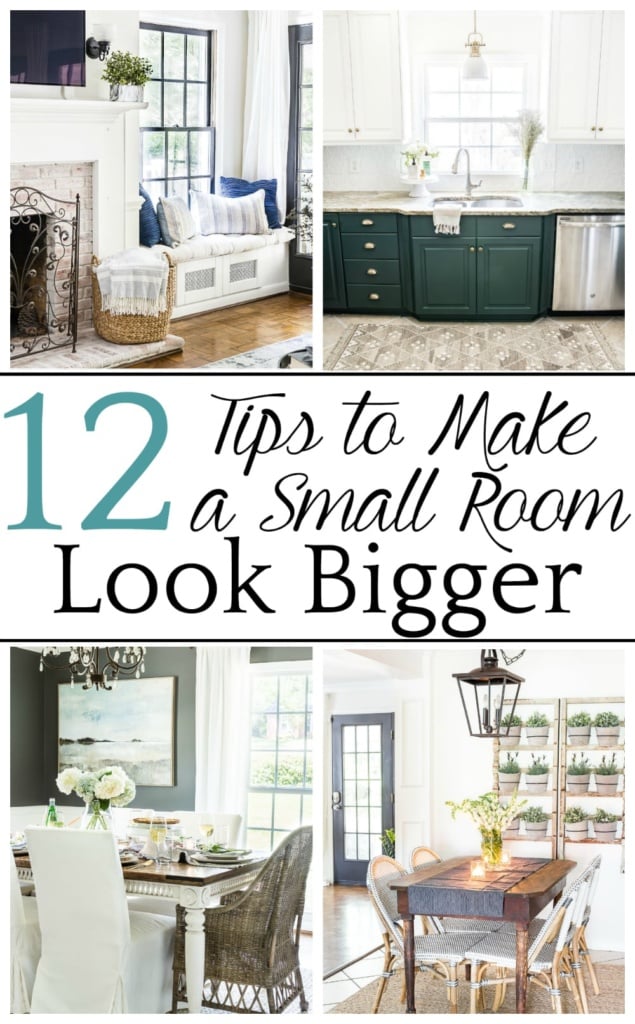12 tips for decorating, furniture selecting, choosing paint colors, and utilizing function to make a small room look bigger.
Even though our 1960 colonial has rooms much smaller than our brand new builder grade house did, I wouldn’t change it for anything. Because even though the ceilings aren’t nearly as tall, there are fewer cabinets, and it is the furthest thing from “open concept” as you can get, we’ve figured out so many tricks to make each room appear to be much larger than it really is.
And then I realized, hey! I haven’t shared any of them!

If you have small-ish rooms in your home that you’ve been challenged with, I hope these tips for tricking the eye can help. And if you look at the photos in this post and think, “That is not a small room,” you’ve officially been visually tricked. 
How to make a small room look bigger:
1. Use very light colors or very dark colors to give a room depth.
Medium shades can make a room appear smaller, but when you use bright whites and deep dark paint colors, you create contrast, which creates depth and the illusion of a larger space. (Our paint colors we’ve used are listed here.)

2. Utilize hidden storage or multi-functional furniture.
We built this window seat for storing all of our TV components for that reason so that it would double as extra seating when we have company over. We use lots of baskets for holding chew toys for our dogs and blankets. If everything you use can be tucked in a designated spot out of the way, you eliminate clutter and give the appearance of space.

3. Hang floor-to-ceiling curtains.
Hanging long curtains just below the ceiling that sweep all the way down to the floor is like putting stiletto heels on a room. Ceilings instantly look higher. I like IKEA’s the best because they consistently carry inexpensive 96″ curtains that are harder to find in other stores.

4. Use a few larger decorative accents instead of many small decorative items
Lots of small knick-knacks tend to feel like clutter and make a room look smaller. Use the triangle rule and symmetry when styling vignettes on coffee tables, nightstands, dresser tops, and dining tables and limit decor groupings to 3 or 5 items. But you don’t need decor accents on every single surface of your home. Let a room “breathe”. See this post for extra vignette styling tips or you can see a video in my Instagram Stories highlights about it.

5. Display large-scale art.
If you have a small room and want to hang wall decor, opt for one large piece of art or a wall accent instead of a gallery wall of smaller items. If you really want a gallery wall with smaller pieces, limit it to the one wall and go simple large-scale on the other walls in the room. And it’s okay to leave some walls blank to prevent the room from feeling cluttered and overwhelming. (Here is some of my favorite large-scale art.)

6. Use a few lamps to spread light evenly around the room instead of relying completely on one overhead light.
Having multiple sources of light in a room can make the space feel more expansive. It’s really helpful in rooms that have limited natural light.

7. Use rugs to define the spaces.
Area rugs help rooms feel finished and pulled together. But they can also create the illusion of more square footage.

8. Opt for a large statement piece of furniture.
It’s better to have a large sofa and 1 accent chair in a living room than 4 accent chairs. If you can fit a king sized bed in a bedroom, go for it. Our master bedroom is just barely large enough for a king-size bed, but it does make the room feel larger than a queen-size would.

9. Buy furniture with exposed legs to make a space feel more open.
Chairs, sofas, and beds with skirts can feel boxy. But if you opt for furniture with exposed legs, it creates the illusion of extra room. (Here are some of my favorite chairs and beds.)

10. Place mirrors on dark walls that don’t get much natural light.
Hanging mirrors allows you to bounce light from windows and create the illusion of more square footage.

11. Declutter, declutter, declutter.
We try to make a habit of decluttering cabinets, closets, and any other rooms that start feeling too “full” every 6 months (typically around Daylight Savings Time) to prevent our home from being overcrowded. Even a large room that is cluttered will feel small.

12. Buy a visually interesting ceiling light fixture.
Incorporating ceiling lights with details draws the eye upwards and adds height to a room. (These are some of my favorite chandeliers, flush mounts, and kids’ lighting.)

Do you have any other tricks you use for making your rooms feel expansive? I’m sure there are plenty more, but those are the ones we usually stick to. And they WORK!
Drop any tips you have in the comments.
If you want to save this post for later, you can pin it here:


The post How to Make a Small Room Look Bigger appeared first on Bless'er House.


No comments:
Post a Comment